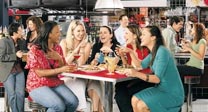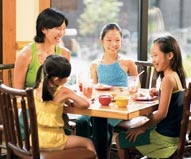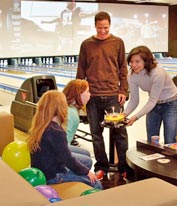
Vol. X, No. 3, April-May 2010
What drives guest attendance? Is all about the motivations
Customers of location-based entertainment venues and restaurants do not classify their visits by industry types or definitions, but rather by how they define the occasion and what is know as conceptual consumption.
In the out-of-home entertainment industry, including what is loosely referred to as the family entertainment center (FEC) industry, we tend to classify venues by types in industry terminology, such as FEC, bowling center, pizza and games, children’s edutainment center, children’s entertainment center, laser tag, etc. As a result, the designs and operations are typically shaped by that mindset, such as a bowling center offers bowling, an FEC offers games and rides, etc. However, that is neither how guests see the venues and experiences they offer nor why they might make the decision to attend. For consumers, it’s all about the occasion and typically not about the specific type of entertainment offered. Some of the most extensive research on guest motivations has been done in the restaurant and cultural attraction industries. Let’s first take a look at the restaurant industry.
In the food service industry, restaurants are typically classified as quick-service (QSR) or fast food, fast casual and full service. However, extensive research by Coca-Cola found that diners view restaurants quite differently in five distinctive groups:
- Entertain ‘n Unwind
- Home Comfort
- Pizza
- Quick Service
- Breads Abound
 Entertain ‘n Unwind is described as, “Adults socializing with alcohol beverages and better quality food in a fun, upscale atmosphere with attentive wait-service at higher prices.” Within this category there are subgroups clustered around theming or décor and fun first where atmosphere tends to dominate to s subgroups at the other extreme where food is clearly the focus. Home Comfort, on the other hand is, “Family relaxing with food that evoke ‘home’ in spacious settings providing informal but caring service at moderate prices.”
Entertain ‘n Unwind is described as, “Adults socializing with alcohol beverages and better quality food in a fun, upscale atmosphere with attentive wait-service at higher prices.” Within this category there are subgroups clustered around theming or décor and fun first where atmosphere tends to dominate to s subgroups at the other extreme where food is clearly the focus. Home Comfort, on the other hand is, “Family relaxing with food that evoke ‘home’ in spacious settings providing informal but caring service at moderate prices.”
When it comes to the key drivers of how consumers select restaurants, it is different than how the food service industry thinks of it in the context of check size and meal or daypart. Consumers pick restaurants based on occasions and need states, broadly segmented by party size and composition and the amount of time they have available to spend.
So how do consumers define restaurant occasions? The restaurant industry categorizes them by industry defined restaurant type and daypart. Consumers on the other hand define restaurant occasions by three general groupings – social, family and quick occasions. These broad groupings break down into 16 distinct restaurant occasions. For example, within the quick grouping, there is serve me quick, inexpensive quick workday lunch, bring me dinner and impulse fuel to go.
The Hartman Group, a consumer behavior research and consulting firm, has done extensive research on occasion-based eating and has segmented it (including restaurant occasions) somewhat differently than Coca-Cola. Their research found that eating occasions are the cultural context that surrounds consumer need states. They see eating as falling within three different types of occasions along a spectrum of increasing sophistication:
- Instrumental – driven by needs not specific to food, such as drinking an energy drink
- Savoring – driven by needs specific to savoring good food, such as having a Starbucks coffee
- Intellectual – the highest quality eating occasions related to how food is produced and driven by desire to parse intellectual distinctions within a category, such as drinking wine from a tiny California winery
Within the restaurant category of eating, this increasing sophistication would go from a fast food restaurant such as Taco Bell (instrumental) to a fast casual restaurant such as Chipotle (savoring) to a fine dining restaurant (intellectual). Hartman also found a social context of the who, when and where of the dining experience and the key needs relevant to the occasion, resulting in many different combinations. One example of a dining occasion using their analytic would be a couple (who) going out for dinner (when) at a restaurant (where) for food that is fresh, has flavor distinction and culinary tradition (savoring). All told, Hartman has identified 100 distinctive American cultural eating occasions.
 Understanding how consumers view restaurants and their dining occasion needs is important to success. For example, within the social grouping defined by Coca-Cola is a subcategory dinner, date & drink. To satisfy that occasion, there has to be the right combination of menu, service delivery and atmosphere, which would be quite different than what it takes to satisfy planned family dinner. Using Hartman’s typology, the dinner, date & drink occasion would need to fall within either the savoring or intellectual food occasion category depending on any number of variables. Success in designing a restaurant rests far more in designing the experience to attract defined dining occasions based on the way consumers view dining experiences and make restaurant choices than it does on defining visits within industry-defined categories.
Understanding how consumers view restaurants and their dining occasion needs is important to success. For example, within the social grouping defined by Coca-Cola is a subcategory dinner, date & drink. To satisfy that occasion, there has to be the right combination of menu, service delivery and atmosphere, which would be quite different than what it takes to satisfy planned family dinner. Using Hartman’s typology, the dinner, date & drink occasion would need to fall within either the savoring or intellectual food occasion category depending on any number of variables. Success in designing a restaurant rests far more in designing the experience to attract defined dining occasions based on the way consumers view dining experiences and make restaurant choices than it does on defining visits within industry-defined categories.
Research on leisure has generally found that there are six basic different emotional or occasion-oriented reasons to engage in a leisure activity or visit an out-of-home leisure venue:
- Social interaction
- Active participation
- Comfortable surroundings
- Challenging, new or unusual experiences
- Opportunities to learn
- A sense of doing something worthwhile
Consumers go to different types of venues seeking different emotional rewards. Regular museum attendees typically go for the challenge of new experiences, opportunities to learn and the feeling that the visit was worthwhile. Conversely people go to musical performances, plays or a dance performance foremost to socialize (notice it’s not for the entertainment).
The Leisure Trends Group’s LeisureTRAK studies over the past two decades have found a similar, but slightly different breakdown of nine leisure motivators that drive leisure behavior:
- Tenacious – complete an activity and gain a sense of accomplishment
- Recuperative – relax among calm surroundings
- Social – share experiences with family and friends
- Intellectual – activities that force me to think and learn
- Pleasure seeking – look for fun
- Competitive – seek to win against myself and others
- Escapist – seek to avoid the stresses of daily life
- Hands-on – tinkering, doing it myself
- Ambitious – activities that contribute to my career or job
Within the location-based entertainment industry, many venues fail to understand the nuances of the type of occasions that motivate guests to visit, and as a result fail to properly design the experience to satisfy those needs. It’s a complex puzzle and the specific types of attendance being sought need to be defined by the occasion as defined by the guest, not the industry. Entertainment is not a consumer occasion. Entertainment can be broken down into many occasion categories as defined by the Leisure Trends Group. Then you have to overlay the restaurant occasion methodology on it, as it is very difficult, if not impossible in today’s out-of-home entertainment landscape to only offer entertainment and not also dining, often meaning destination dining.
 Many times it is the social nature of the occasion that is primarily driving the visit, not the entertainment or food. The social aspect of the occasion is where so many entertainment, as well as restaurant venues, fail to meet true potential by not understanding and designing the gust experience to offer the desired social outcome. Too often the focus is on the entertainment and/or the food and not all the other aspects of the experience that need to be properly executed to facilitate the socialization. Acoustics is one. Socialization means conversation, which in turn means an environment where you can talk and be heard clearly without shouting. We can’t tell you how many people we know who have told us they avoid certain entertainment facilities and restaurants due to the noise levels. We have even had children as young as age five tell us in focus groups they don’t like to go places because of the noise. Many restaurant reviewers are now rating the noise levels of restaurants along with the food, service and atmosphere.
Many times it is the social nature of the occasion that is primarily driving the visit, not the entertainment or food. The social aspect of the occasion is where so many entertainment, as well as restaurant venues, fail to meet true potential by not understanding and designing the gust experience to offer the desired social outcome. Too often the focus is on the entertainment and/or the food and not all the other aspects of the experience that need to be properly executed to facilitate the socialization. Acoustics is one. Socialization means conversation, which in turn means an environment where you can talk and be heard clearly without shouting. We can’t tell you how many people we know who have told us they avoid certain entertainment facilities and restaurants due to the noise levels. We have even had children as young as age five tell us in focus groups they don’t like to go places because of the noise. Many restaurant reviewers are now rating the noise levels of restaurants along with the food, service and atmosphere.
Socialization brings up the need for food and beverage. It must go back to sitting around the primal campfire when early man ate as group. People seem to need food or beverage to enjoy a social occasion. That probably explains why the eatertainment venues have far outlasted many pure entertainment ones. You might not remember Mountasia & Malibu Grand Prix FEC chain. That is because it was all about entertainment and didn’t last. More than 25 years old, eatertainment concepts like Chuck E. Cheese’s and Dave & Buster’s are still going strong since about half their sales are from food and beverage.
There is another twist to defining the motivation for the occasion. It’s what is known as conceptual consumption. There are often psychological motivations not directly linked to the leisure activity that drive the decision-making. The concept of sustainability and green is driving a lot of decisions, including visits to location-based entertainment. When people choose to visit a facility due to its green or social responsibility aspects, they are not only consuming leisure experiences or physical goods like food and beverage, but are also consuming the concept of being a responsible citizen. Another example is attending a charitable fundraising function at an entertainment venue
As sociologists and anthropologists in the field of consumer behavior have pointed out for many years, physical and entertainment consumption (of brands) is used not just to satisfy basic needs but also to signal to others and ourselves our beliefs, attitudes, and social identities. Conceptual consumption can occur independent of, and in some cases can even trump, the physical and experience consumption. Examples include people who purchase high-priced consumer goods not merely to enjoy the utility of the quality product but also to display their wealth to others, consuming the social status that results, or frequenting a particular entertainment venue, such as a nightclub, as being there symbolizes having status or wealth.
It is important to remember that no facility can expect to attract all the different types of guests for all the different type occasions and consumption concepts. In fact, the more different types a facility tries to attract, the less successful it will become. Success is all about targeting market segments based on many factors including who the guest is along with a number of dimensions including group type, socio-economics and the type of occasion and consumption concept. This is known as focused assortment – clearly defining the target by the who, the occasion and the concept, and then offering the best focused assortment that satisfies that target. Some groups of people and occasions are compatible within a venue. Many are not. Trying to be all occasions to all people only results in not being special to anyone.
Success is all about understanding how guests view and classify their visit decisions through their complex lens, much different than the way most venue owners traditionally see their businesses, and then designing and operating the business to match the guest needs and wants based on the way they classify their visits.


